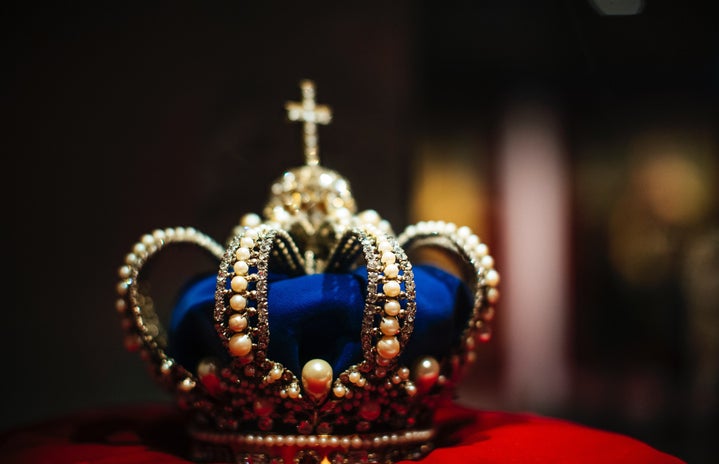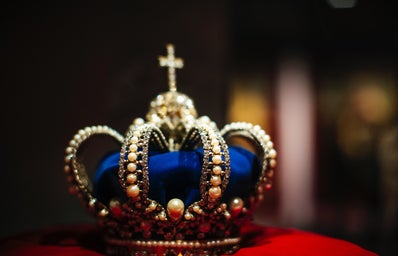Divorced. Beheaded. Died. Divorced. Beheaded. Survived. Have you ever heard those words in this order? They are referring to the six wives of Henry VIII, former English king from 1509 to 1547. He is globally known for his rupture with the Catholic Church, however, his wives are way more interesting.
Katherine of Aragon
Daughter of the couple who consolidated Spain as we know it nowadays, Katherine was married to the Prince of Gales, Artur.
Sadly, in 1502, four and a half months after their union, when she was seventeen years old, the newlyweds were hit by the plague – but she was the only survivor.
To keep a favorable accord between England and Spain, Artur’s father, Henry VII, married young Katherine with his other son, the next in line of succession to the English throne, Henry VIII.
The monarchs had two children, the future king of England: Henry, Duke of Cornwall, who unfortunately passed away as a newborn, and the future queen of England, Mary I – the first queen to reign alone in England’s history. Henry’s hopes were high, and as soon as her daughter was born, Henry told the Venetian Ambassador: “We are both young; if it was a daughter this time, by the grace of God the sons will follow”.
However, as Katherine was getting older and still hadn’t gotten her husband a healthy male heir. And Henry, well, he was a man, and when a young noble, a beautiful English girl arrived at the court as a lady-in-waiting with her sister to Katherine of Aragon, he couldn’t help but obsess with her.
That said, Henry would try to get an annulment with the Pope alleging that his deceased brother had consummated their marriage and thus we would be marrying his sister.
Katherine was not described as England’s first feminist queen a mistake? No. She defended herself by announcing that she was a virgin when she married Henry and was his true wife for the last twenty years. Besides being described as a feminist queen, you can also find her being so-called stubborn and powerful. And she got what she wanted: the annulment was denied.
Following the Renaissance vibe and the breaks up with Rome all over Europe, the King saw what he had to do to marry his new love: build his church and become its head.
Katherine’s end is very cruel, she was kicked out of the palace in 1531 and would never see her daughter ever again. The catholic ex-queen, in her last letter to Henry, still signed as Queen of England. The Queen died in 1536 and the young English girl wore yellow to the funeral.
Anne Boleyn
The noble English girl has a name, a famous, iconic, and polemic one: Anne Boleyn, the girl who changed the course of history.
Born circa 1500, Anne went to live in France when she was about 13 years old where she learned how to behave like a lady: sing, play the piano, and have good manners.
Back in England, Anne gets closer to the palace because of her sister who was one of Henry’s mistresses and both became Aragon’s ladies-in-waiting.
Anne is purported as a flirting woman, but she was probably just young, charming, cool, and beautiful. It caught Henry’s eye and pursued her to be his mistress, but she would prefer marriage.
While in his battles with Rome, it is rumored that Anne gave to the King a copy of Obedience of a Christian Man, by William Tyndale, which defends that the Catholic Church is not the ruler, the bible is.
Even though Katherine and Henry were officially divorced only in May 1533, in January, Henry and Anne married secretly while she was already pregnant. In September, to the disgust of the king, Elizabeth I was born – the Imperial Ambassador Eustace Chapuys described her birth as cold and disagreeable.
Then, in 1534, England broke up with Rome.
Lamentably, the future Queen would be their first and last child, since Anne suffered miscarriages in the following years. Because of that, their marriage was getting cold and they were unfollowing in love.
However the final straw for her end as a monarch was a fight with Henry’s right-hand man, Thomas Cromwell. Instead of using the money from the sale of monastic property to charity, Anne’s desire, it went directly to the crown.
Cromwell denounced her for adultery and even if Anne said that it was all completely fake accusations, Henry was already running after one of her ladies in waiting, Jane Seymour.
She was tragically beheaded in 1536, when she was being put in the right place, she joked: “I heard say the executioner was very good, and I have a little neck”, says the Constable of the Tower.
Henry, whatsoever, used this awful opportunity to eleven days later marry the love of his life.
Jane Seymour
Known as the only one he truly loved, Jane Seymour is much more than the love of Henry’s life.
Dismally, her story is not so famous and familiar, but she was Aragon’s and Boleyn’s lady-in-waiting.
Following the same logic as Anne, Henry, obsessed with Seymour, asked her to be his mistress but she refused and only accepted marriage. So, his love for Jane was also an excuse for beheading poor Boleyn.
However, Seymour’s story does not end with hate.
About a year later, Jane gives birth to the male heir of the Tudor dynasty, Edward VI, with that phenomenon, Jane instantly became the love of Henry’s life. But, maybe it was karma, she died 12 days after his birth because of post-birth complications.
Anne of Cleves
Henry was probably one of the first people to fall in love with a catfish.
Born in Cleves, a territory that nowadays is a part of Germany, Anne was a secure match for England’s king, who, despite the grief, wanted as many male heirs as possible to secure the Tudor Dynasty.
The colossal renascent artist, Hans Holbein was in charge of painting Anne and Amelia’s, her sister, portray the king to choose a wife – Tinder is not a very creative modern-day dating solution…
Why would Henry go so far away to secure his match, you ask? Well, just like England, Cleves was a Catholic Estate but was available for religious reform.
Fascinated by Cleve’s looks and beauty according to her portrayal, a 24-year-old king ordered her to come to the court to meet him.
Following a tradition to dress in disguise to meet the Queen, so she would not recognize him, in 1540, Henry did it, but she did not receive him with such cordiality.
Rumors have it that she pushed him away or ignored him.
Neither of them was happy to be marrying each other, thus, Henry confessed to Cromwell that they had not consummated the marriage. “’I liked her before not well, but now I like her much worse,” affirmed the king. “[…] His Highness verily thinks that his nature would not consent to do so”, said Cromwell.
In July of the same year, Henry would ask for an annulment as their marriage was never consummated, however, Anne’s word was never listened to. She was only told about their “divorce” after it was formalized.
Nevertheless, she lived an extremely joyful life. Her days were based on learning English, drinking wine, and enjoying fashion and sports. Along with this, she kept in good terms with the king and his daughters.
Katherine Howard
One must not compare the Queens, but miserably, Katherine is the one who suffered the most in her short life of seventeen years.
Born in 1524, Katherine is cousins with Anne Boleyn, so, lamentably, the same family is not the only thing that they have in common.
Katherine was also related to Jane Seymour.
She and a few of her 10 siblings were sent away to live with their father’s stepmother and cousin, Agnes Tilney, the Dowager Duchess, after the death of their mother. She was about 4 years old when her mother passed and about 10 when she went to live with Tilney.
Besides her good manners, she was not very inclined to a higher education except reading and writing, so she would make a perfect wife. She was also raised as a catholic.
When she was a pre or young teen, she had a music teacher called Henry Mannox. “At the flattering and fair persuasions of Manox being but a young girl I suffered him at sundry times to handle and touch the secret parts of my body….”, she confessed. Even though they were caught together and were prohibited – blaming their affair on Katherine by beating her up and not firing Henry – from being together alone, the Duchess would not mind what the young ladies were doing under their roof, she just wanted them to get a good suitor – who would not be a mere music teacher.
It is said that their “relationship” was consensual, but how could it be if a thirteen-year-old girl was “seduced” by a full-grown man? In a book called Power and Control: Katherine Howard’s Relationships by Conor Byrne, she described Mannox as a man of “flattering and fair persuasions”. In a patriarchal society, even though Katherine had a higher social status than Mannox, he was still a man gaslighting and taking advantage of a young naive girl.
A few times later, she moved to a London neighborhood called Lambeth, where Katherine, now fourteen, met Francis Dereham, the Duchess’s secretary. And if you think Mannox was an asshole, wait to see Derahem.
At 14/15, he began to hit her up. She would sneak him into the girls’ rooms. Her roommates said that they could not sleep since there was a strong sound of “panting and puffing” and that they were “’hanging together by the belly like sparrows”.
Later on, she admitted that she never got pregnant because she knew how to not conceive, and that method was: not enjoying sexual acts, after all, as reported by her, to be with a child meant being satisfied during the act..
Aside from abusing Katherine, Francis would ever and again court her and call her his “wife”. The proposal would never happen because she became Cleve’s lady in waiting – but he would go after her even when she was coronet a queen.
Katherine was thirty-three years younger than the king, who was getting older and uglier every day, at that time. The combination of an ill man in an unhappy marriage and a young and enchanting lady is explosive.
“Divorced” Cleves, Henry presented Howard as his wife on July 28th, 1540. But Henry was fifty years old. He was indisposed, old, and not attractive at all.
That’s when Henry’s close friend, Thomas Culpepper shows up. He only hasn’t gone to jail because he was the king’s bestie, since he was already changed with rape and murder.
He would simply ask Katherine for favors, but soon they began to secretly meet when they were on a trip, even though it is not known if they consummate their illicit affair. In that summer, Howard wrote to him: “’It makes my heart die to think I cannot be always in your company […] “Yours as long as life endures”.
Her downfall began when Thomas Cranmer, the Archbishop of Canterbury and a reformist who wanted to take a Catholic off the throne, began to search for evidence that her Majesty was unfaithful.
It came all at once: one of the girls who lived with Katherine, Mary, disclosed Howard’s “affair” with Thomas and Francis Dereham. Henry did not believe, so he ordered him to do deeper research.
Both men were interviewed, and both admitted the affair but denied that they had sex with the young queen. As traitors, Dereham died by hanging and Thomas as he was a dearest friend of Henry, by beheading.
Then the Archbishop locked Howard in her apartment and she admitted her affairs, “I was so desirous to be taken unto your Grace’s favour and so blinded with the desire of worldly glory that I could not, nor had grace, to consider how great a fault it was to conceal my former faults from your Majesty, considering that I intended ever during my life to be faithful and true unto your Majesty after”, justified Katherine with mercy.
It is said that the King was very depressed and would never recover from it since he truly loved Katherine, but do not feel empathy for him, please. He asked to never see her ever again.
Dear Katherine, was beheaded on the 13th of February, 1541, aged 17 or 18.
There is an urban legend that people can see Katherine’s ghost and hear her screams for mercy at Hampton Court.
Katherine Parr
Last, but not least, there is always a survivor and in this story, her name is Katherine Parr.
Above a wife, Katherine was the first woman in England to publish a book using her name.
Her parents were close to the court since her mother was a lady in waiting for Katherine of Aragon, who probably inspired the couple to name her daughter after, and her father was a courtier of Henry when he was young. After the death of her father, her mother raised Parr as an academically smart girl – she spoke French, and Italian and learned Spanish and Latin.
Katherine was not a young lady when she met Henry she had a few marriages before becoming queen.
Mr. Edward Borough was her first marriage, with whom she married at 16. He was a chamberlain of Boleyn! He died in 1533.
Alone in life and poor, Katherine went to live with her relatives in northern England just to meet her second husband, John Neville – and he came from a wealthy family! He had two children from prior marriages.
However, she had hard times during a rebellion against the English Reformation – this led to Neville being apprehended and she and the children locked at their house.
Traumatized, the family moved to southern England and her husband started to show illness. Not willing to be a widow again, she began her search for a love match – that’s when she met Thomas Seymour – Jane’s brother.
She instantly fell in love with him as she wrote: “My mind was fully bent the other time I was at liberty to marry you before any man I know”.
On the other hand, the king also instantly falls in love with Parr. As soon as John died, she was asked to be the new queen of England. She did not want to marry him once she was already in love, but as she was a woman and had a lot of pressure on her, she had no other choice.
Along with being a joyful companion to the old king and dear stepmother to his children, Parr has a crucial role in History, after all, she was the one who made Henry restore harmony with his daughters, Mary and Elizabeth, and put them back at the line of succession.
Parr was also very important in England’s diplomacy and had a religious conspiracy against her.
At 55, in 1547, Henry VIII died of a failure of his heart or kidney, it is not well known. She remarried, this time her long-time crush, Thomas Seymour – even though the king, Edward VI, did not approve. Elizabeth thought it was disrespectful to her father, but they made peace and started living together. Seymour visited Elizabeth’s room at night and touched her in front of everyone, to protect her, Parr and Seymour sent her away.
In 1548, Katherine finally gave birth to a beautiful girl named Mary – the Aragon bloodline is 100% compatible with the Parr – but Katherine did not see her dear girl glow, since she died 15 days after giving birth.
—————————————————————–
The article above was edited by Giovanna Rodrigues.
Like this type of content? Check out Her Campus Casper Libero for more.


